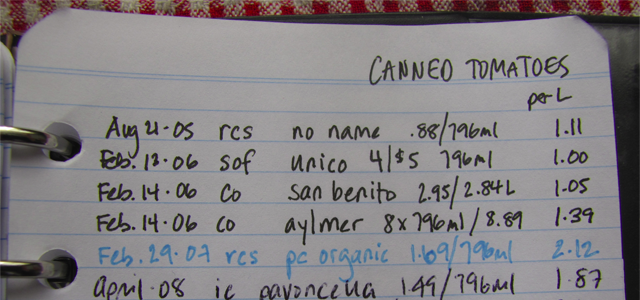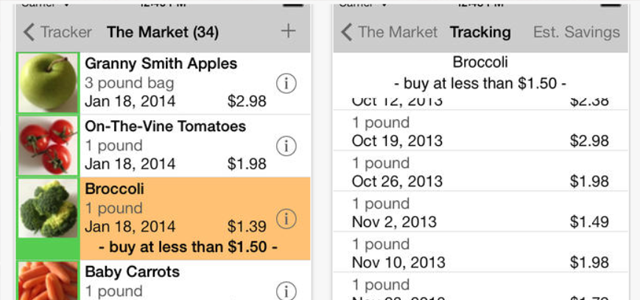A price book, which tracks the lowest prices on the products you buy most often, is the best tool for saving money on supermarket shopping and household items. With it, you’ll always know when a sale is really a good deal, when produce is in season, and when to stock up on the essentials. Here’s how to make and keep this time-tested savings tool yourself — and save as much as $1000 a year.
Why You Should Use A Price Book
Sales on household items, as you might already know, are cyclical. Knowing how often a product goes on sale, or what the difference between the “regular” and “sales” price is, can make a big difference. That’s where the price book comes in — it’s a personalised, local guide to the very best deals.
Let’s say you usually buy four cans of a certain type of soup every month, usually for $3.29 a can. Every few weeks, however, the price drops to $2.50 a can. In this example, you’ll save S3.16 each month by waiting for the lowest price. It might not sound like much, but that’s nearly $40 in savings a year, and if you multiply that with dozens of similar items, you can see how the savings add up.
It takes a little effort setting one up and maintaining a price book, but it could make you a more savvy shopper. So here are instructions and a few tips for making your own price book.
Track Per Unit Pricing
The most important part of using a price book is to track the per unit pricing on each item — the price by weight or volume for a fixed amount. Australian supermarkets must display this figure. It’s generally consistent across particular product categories, but there are exceptions. Make sure you’re comparing the same unit (don’t mix up per 100 gram pricing with per kilogram pricing).
Choose Your Format: Paper Or Digital
Both paper and digital price books have advantages. A paper notebook is quicker to jot down prices and refer to when you shop, but apps make quick work of calculating prices (plus, they serve as shopping lists). Either way, you might want to start by tracking just 10 to 20 items you buy most often, to make it easier at the start, but that’s up to you. You also don’t have to track prices as you shop — you can do it from your receipts.
How To Make A Price Book Notebook

On each page of a notebook, list an item that you buy frequently (e.g., coffee) and the unit for comparison (e.g, per 100 grams). Then, when you shop, list the date, store, product brand, price and unit price. After several weeks or months, you should have a lot of data and can use a pencil to circle the current lowest price for reference when you shop. The photo above is an example from GoodLifeGazette, which offers a very detailed guide to Pricebooking 101.
Instead of tracking every store or time you shop, you could also simply cross out or erase the price on an item in your notebook and replace it with a new price whenever you find it lower.
Digital Price Book Tools

Spreadsheets: Trent over at The Simple Dollar details how he created a price book in Google Docs. Since it’s accessible from his phone, he says it’s easy to update. His version lists items in the first column — kilogram of bananas, loaf of bread, ;otre of milk — and store names in the other columns, plus a total line at the bottom that adds up the prices for each store. This seems most useful for identifying which store has the best prices for particular items.
If you don’t shop at many different stores, a better solution may be to set up your spreadsheet with columns like the example above. Then you could sort by products. A nice thing about this system is it calculates the unit price for you. You could add a category column or use a different sheet for each category.

Mobile apps: Mobile apps may be the best option, since you’re always going to have your phone with you, and apps contain smart features like highlighting the lowest prices. That said, many apps in this space are US-specific and won’t work easily with local pricing and units.
Setting up a price book takes effort, but the results can help you save significantly, even if there’s only one convenient supermarket in your area. Have your own price book tips? Share them in the comments.

Comments
One response to “How To Save Heaps On Your Supermarket Bill With A Price Book”
I started doing this a few months before my first child was born, specifically to track baby consumables (nappies, wipes, formula, nappy cream, etc). Used a Calc spreadsheet in GDocs on my phone and saved alot of money in the long run.
The only thing I wish I’d learnt earlier was that some cheap nappies are good enough. Spent a fortune on Huggies to begin with, then transitioned to using Huggies at night and cheapies during the day. Then eventually went all cheap (after he got to an age where he wasn’t doing heavy nappies during the night).
For everyday groceries I just try to keep track in my head of what an acceptable price is per unit, and also keep track of which items regularly go on sale (e.g. soft drinks are on sale at least every fortnight).